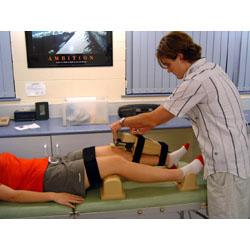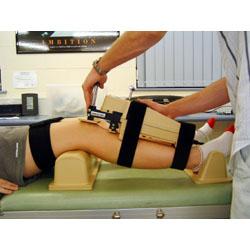Oestrogen increases risk of sports injury in females
Published on 23 October, 2003
Women are being warned that they may be at greater risk of incurring an ACL (anterior cruciate ligament) injury – one of Australia’s most costly and common sports injuries – during their ovulation phase of their menstrual cycle.
Preliminary results of a Central Queensland University study on the relationship between hormone fluctuations and ACL injuries in teenage netball players has shown that women are more at risk of injury when their oestrogen levels are at their highest.
 CQU lecturer and supervisor of the study Adam Bryant said the preliminary results should be seen as a warning to women to take precautions when considering participation in high-risk sports such as netball and basketball when their oestrogen levels are at their highest around ovulation.
CQU lecturer and supervisor of the study Adam Bryant said the preliminary results should be seen as a warning to women to take precautions when considering participation in high-risk sports such as netball and basketball when their oestrogen levels are at their highest around ovulation.
The world-first study involved 8 female A-level netball players and six male students, aged between 15 and 19 years. The male students made up the control group in the study.
Visiting German medical student Elisabeth Eiling, of Kiel University, undertook the study under the supervision of CQU School of Health and Human Performance biomechanics lecturer Adam Bryant and Rockhampton orthopaedic surgeon Associate Professor Dr Erik Hohmann.
“During the study we looked at the fluctuations of the hormones oestrogen, progesterone and relaxin and their effects on the knee joint,” Mr Bryant said.
“We brought the test subjects in during different times of their cycle (every week over the 28-day menstrual cycle) and looked at the movement in the knee joint and at how stiff their muscles were.
 For each testing session participants were required to do different biomechanical tests in order to determine the stiffness and laxity of their knee as well as being filmed doing netball landings on a force plate to create movement data on the biomechanics of landings.
For each testing session participants were required to do different biomechanical tests in order to determine the stiffness and laxity of their knee as well as being filmed doing netball landings on a force plate to create movement data on the biomechanics of landings.
Mr Bryant said the results would transfer across a range of sports that require participants to stop suddenly, including soccer and squash.
“This is a ground-breaking study with plenty of potential to reduce the costs associated with anterior cruciate ligament damage in Australia,’’ he said.
This will be presented at the Pre-Olympic Orthopaedic Congress in Athens next year.

